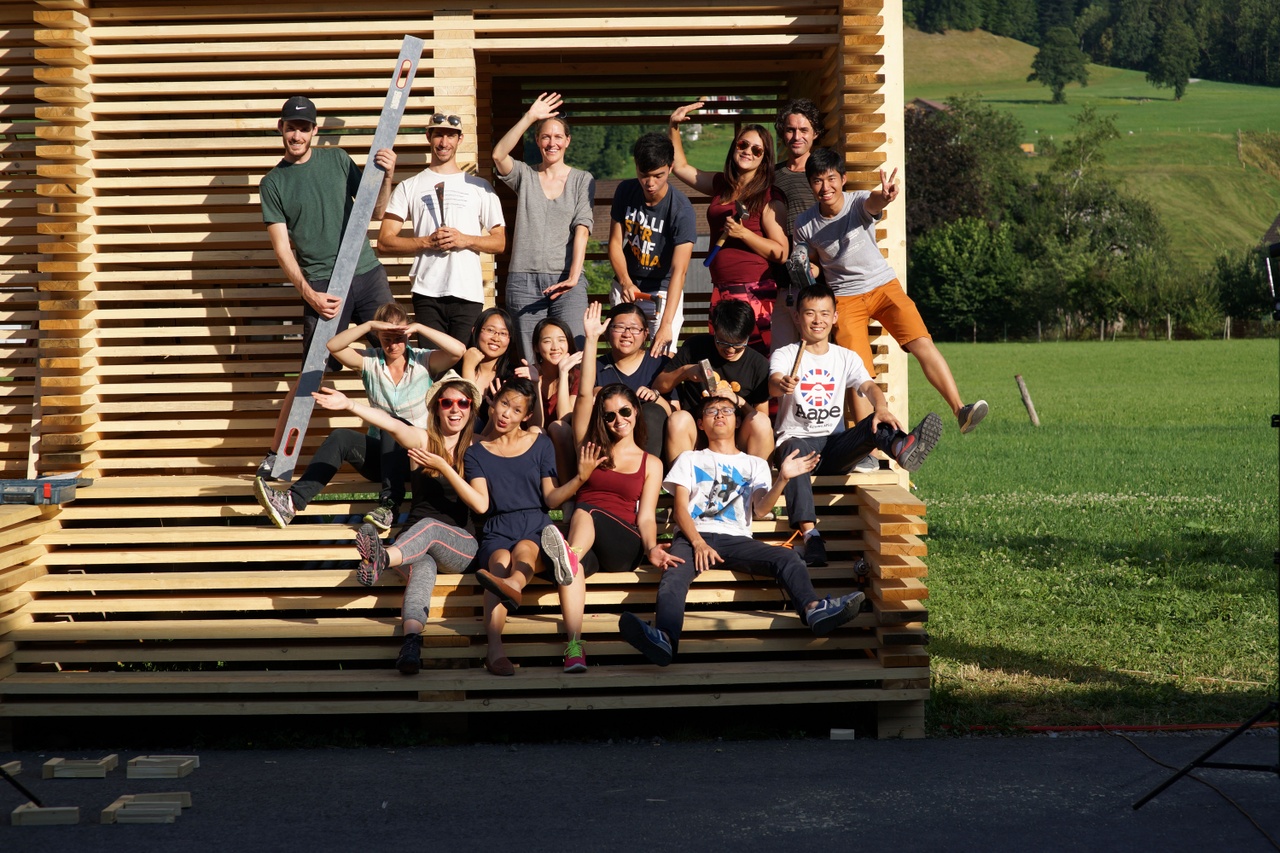At Andelsbuch in the Bregenzerwald [Bregenz Forest] there is a ‘small hotel’ which shows just how creative sustainability can be. Architecture students of the University of Liechtenstein’s Summer School of Arts & Crafts 2015 have found out with their own hands what the intelligent use of resources means – assisted by crafts workers from the Bregenz Forest.
At Andelsbuch in the Bregenzerwald [Bregenz Forest] there is a ‘small hotel’ which shows just how creative sustainability can be. Architecture students of the University of Liechtenstein’s Summer School of Arts & Crafts 2015 have found out with their own hands what the intelligent use of resources means – assisted by crafts workers from the Bregenz Forest.
‘We just put together bits of wood four metres long, board by board, like Lego bricks, until we had the prototype for a two-room hotel,’ says Sofia Hoch, who feels as much at home in Liechtenstein as she does in Costa Rica. She is one of the 15 architecture students attending the Summer School of Arts & Crafts, which took place in mid-July for the first time at the University of Liechtenstein. Students from all over the world took part in workshops – one week at the university in Vaduz and another week at the Werkraum Bregenzerwald [Bregenz Forest Working Space], a cooperative of craft workers in Andelsbuch – to develop their craft skills and artistic talents.
The idea behind the project was summed up by Hugo Dworzak, Head of the university’s Institute for Architecture and Planning. ‘On the one hand we have an accomplished crafts worker from the Bregenz Forest, on the other an artist to inspire him – put them together, and you get an excellent architect,’ he says. ‘The University of Liechtenstein is a central interface for joining regional awareness and international aspirations,’ points out Carmen Rist-Stadelmann, Coordinator of the Summer School, illuminating another aspect.

Bregenz Forest crafts workers as mentors
In Werkraum Bregenzerwald the University of Liechtenstein found an innovative partner for the purpose. Designed by the well-known Basel architect Peter Zumthor, this house dedicated to crafts is the perfect demonstration that contemporary architecture in Vorarlberg is both ambitious and quality-conscious. And the same is true of the independent and design-oriented crafts scene in the region.
Mutual understanding is an important part of the culture of the Bregenz Forest, as it is of the architectural profession, recalls designer and architect Andreas Mohr. He was responsible for directing the ‘Two-room Temporary Hotel’ project. And because you can’t learn arts and crafts out of a book or from the computer, 11 of the 85 master craftsmen at the Working Space became mentors for the architecture students, who came from the USA, Hong Kong, China, Canada, Colombia, Scotland and Costa Rica.
The objective was to build two hotel rooms. The crafts persons involved included specialists in timber structures, natural stone craftsmen, joiners, upholsterers, rope workers, solar specialists, electricians, installers and a lady specialising in felt work. The future architects and the profiled crafts specialists together chose the materials, and then built, hammered, sewed, installed, insulated and improvised together. The main idea was to focus on the essential aspects. The new creation was to be modern, well lit, rectilinear, and economical in terms of price and resources.

West meets east in two hotel rooms
‘To make the curtains, we recycled furniture packing materials, and the naturally white cushion on the balcony bench is filled with straw,’ says Sofia Hoch. ‘The view of the meadows and the mountains is fantastic. The showers are fed with rainwater from the flat roof, and the shower water then goes into the WC cisterns,’ she adds, explaining the design. The two hotel rooms each measure around 15 square metres – uncompromisingly based on the motto that less is more.
Light bulbs hang from black cables. The bedside tables to the left and right of the double beds are ornamented with felt lilies. On the floor by the bed there are felt slippers. ‘The architecture students really got a grasp on felt as a material, with their heads as well as with their hands,’ says Marianna Moosbrugger. The artist from Au specialises in felt designs. ‘West meets east, and sustainability meets translucency,’ is Hugo Dworzak’s summary of the ‘small hotel’ for four guests, which was created just in the space of a week. At the end of the Summer School on Saturday, 18 July 2015, he emphasised the importance of the artistic imagination, as a crucial element for producing good architecture.
So in the first week of the Summer School the young people had also been stimulated by artists from Spain, Hong Kong, and Austria’s Vorarlberg region to try out new things. At three workshops in Vaduz they sketched, made drawings and modelled in plaster. ‘Some experimented with Tablet and brush, others tried water colours,’ relates Sofia Hoch, and shows their pictures as an illustration of the way in which the historic centre of Feldkirch can be accurately captured in perspective without any loss of originality.

Second Summer School planned
The second edition of the Summer School of Arts & Crafts of the University of Liechtenstein is already in the pipeline. ‘Students from all over the world were enthusiastic about the idea that architecture can combine the best in crafts work with inspiring art,’ says Carmen Rist-Stadelmann. At all events, the ‘small hotel’ at the Andelsbuch Working Space can be seen and experienced until the beginning of October.
www.uni.li/summerschool and www.werkraum.at
